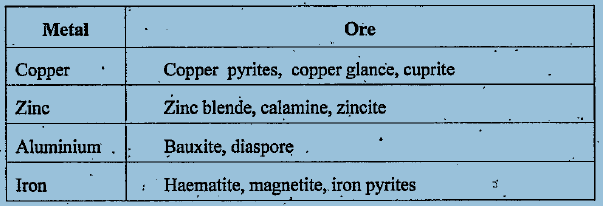10. A student 'tried to find out the standard reduction'potentials of copper electrode and Zinc eleetrode separately using Normal Hydrogen Electrode as reference electrode. He obtained the reduction potentials of E0Cu2Cu as 0.34 and E0zn2+zn as- 0.76. The, reference electrode acted here as cathode in one case and anode in theother.',
1. In which cases NHE acts as cathode and anode respectively.
2. Represent the electrode reactions of the NHE in both cases.
3. Represent the cell reaction when he used the Cu electrode and NHE.
4. Calculate the standard' potential of the cell constructed using Zn and Cu electrodes.Solution in Malayalam
I. With Zinc-electrode NHE acts as cathode and with copper electrode it acts as-anode: 2. As cathode :H⋅+le12H2 As anode : 12H2H⋅+≤− 3. Cu2++H,Cu+2H+ 4. Eon⋅=Ecathode0−Eanode0− =0.34=0.76=1.1 Volt
Topper's Solved these Questions
Similar Questions
Write the formulas for the following coordination compounds: i) Tetraamminediaquacobalt(III) chioride ii) Potassium tetracyanonickelate(II) iii) Tris(ethane-1,2-diamine)' chromium(III) chioride s iv) Ámminebromidochloridonitrito-N-platinațe(II) v) Dichloridóbis(ethane-l,2-diamine) platinum (iv) nitrate vi) Iron(III) hexacyanoferrate (II)
View SolutionAnalyses the table given below:
 Which of the ores mentioned in the above table can be concentrated by magnetic separation method? Justify your answer.
Which of the ores mentioned in the above table can be concentrated by magnetic separation method? Justify your answer.
View SolutionThe following are some statements about normal hydrogen electrode a) when a Zn electrode is in combination of NHE, Zn electrode acts as cathode b) when a Cu electrod is in combination with NHE, Cu electrode is the anod c) When a ''Ag'' electrode is in combination with NHE,Ag electrode is the anode d) When a chlorine electrode is in combination with NHE, chlorine electrode is the anode
View SolutionThe standard EMF of the cell : Ni|Ni2+∣∣∣Cu2+∣∣Cu
is 0.59 volt The standsard elctrode potential (reduction potential of copper electrode is 0.34 volt . Calculate the standsard electrode potential of nickel electrode
View Solutionकथन : Zn/Zn2+ इलेक्ट्रोड को मानक हाइड्रोजन इलेक्ट्रोड के साथ संयुक्त करने पर इलेक्ट्रान जिंक इलेक्ट्रोड से हाइड्रोजन इलेक्ट्रोड को ओर प्रवाहित होते है ।
कारण : जिंक इलेक्ट्रोड का मानक अपचयन विभव हाइड्रोजन इलेक्ट्रोड को अपेक्षा अधिक होता है ।
View Solutionएक सेल जिसमें Zn इलेक्ट्रोड तथा नॉर्मल हाइड्रोजन इलेक्ट्रोड (NHE) हो , इसमें Zn इलेक्ट्रोड किसकी भाँति कार्य करते है -
View SolutionThe emf of a galvanic cell with electrode potential of Zn2+/Zn=−0.76V and that of Cu2+/Cu=+0.34V is
View SolutionThe standard reduction potential of Zn2+∣Zn electrode is −0.76V. What will be the electrode reactions if this electrode is coupled with a standard hydrogen electrode?
View Solutionयदि रजत इलेक्ट्रोड जिसका मानक अपचयन विभव है को मानक हाइड्रोज़न इलेक्ट्रोड के साथ के युग्मित करके सैल बनाया जाये तो रजत इलेक्ट्रोड, एनोड का कार्य करेगा या केथोड का और क्यों ?
View SolutionThe standard electrode potential of Zn2+∣∣ZnandCu2+∣∣Cu are - 0.76 and 0.34 V respectively . The standard e.m.f. of the cell is :
View SolutionWhen the zinc electrode having reduction potential – 0.76 V is attached to NHE, will it act as anode or cathode?
View SolutionThe following are some statements about normal hydrogen electrode a) when a 'Zn' electrode is in combination of NHE, Zn electrode acts as cathode b) when a ‘Cu' electrode is in combination with NHE, Cu electrode is the anode c) when a ‘Ag' electrode is in combination with NHE, Ag electrode is the anode d) when a chlorine electrode is in combination with NHE, chlorine electrode is the anode
View SolutionWhen the zinc electrode having electrode reduction potential -0.76V is attached to NHE, will it acts as anode or cathode?
View SolutionThe Standard electrode potentials of some electrodes are given below:
E∘_(Zn2+Zn)=−0.76V,E∘(Cu2+Cu)=+0.34,E∘_(Ag,Ag)=+0.80V,E∘_(H,H2)=0V
Zinc or copper which can displace hydrogen from dil. H2SO4
View SolutionHere is an electrode reactin :
Cu→Cu2++2e
At which electrode (anode or cathode) would such a reaction take place ? Is this an example of oxidation or reduction ?
View Solution
